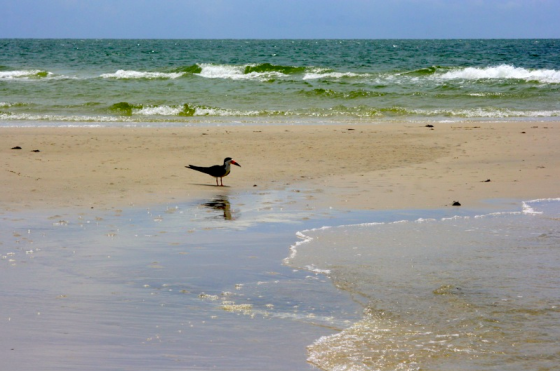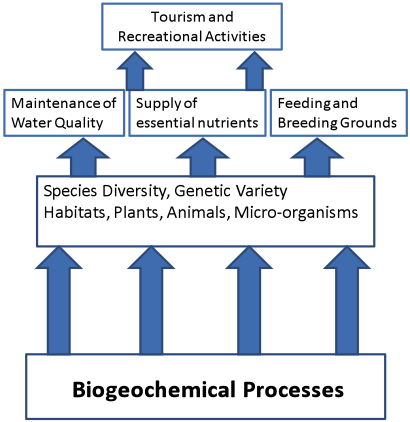The Gulf Oil Spill and its Effects on Ecosystem Services by Junu Shrestha
Along 3,086 miles of coastline in Louisiana, and 1,598 miles of mostly beaches in Mississippi, Alabama and Florida, oil from the BP spill of summer 2010 has been detected. These areas cover sensitive habitats and valuable ecosystems such as wetlands, submerged aquatic vegetation, beaches, mudflats, and deep and shallow corals. The spill poses a significant risk to over 400 species of organisms in these habitats, including fish, shellfish, bottom dwelling biota, birds, marine mammals and turtles. The effects of the spill have extended beyond the flora and fauna of the coasts, and have made its mark on human lives and livelihoods in the region.
Direct impact of the spill was vivid in the oil drenched birds and turtles that grabbed headlines after the spill reached the shores. This major environmental challenge has also demonstrated the connectivity of these coastal ecosystems, and highlighted the dependency of humans and other organisms alike on the coastal ecosystem services. Ecosystem services are the benefits we derive from natural systems, and these services are supported by underlying biogeochemical processes in these systems (Figure 1). Biogeochemical processes include nutrient and redox cycles and involve biological, physical and as well as chemical interactions.
News media has cast a well deserved spot light on damages the spill has caused on human livelihoods and economies in the spill affected areas. For many families that have been relying on fishing and shrimping in the Gulf Coast like the Greco family, their means to earn a living and more importantly their way of life is in peril. As the cleanup plan struggles with tar balls and other unsightly remnants of the weathered oil, several key beach areas, including Pensacola (FL), Bon Secour National Wildlife Refuge (AL) and the barrier islands off Mississippi’s coast have been eerily devoid of enthusiastic tourists, and this has severely hampered local businesses that thrive on the tourist industry. The closed signs on the beaches and the fishing boats idly sitting on the docks give images of people and economies that are still struggling because of the spill. The recreational value of marshes of Louisiana alone was estimated at $147.57/acre/year in 2007 dollars. Though the estimate does not explicitly include economic returns to the local businesses, it gives an idea of economic loss due to the stalling tourism on the Gulf Coasts. The abundance of crabs, fish, oysters and shrimp that support lives of many fishing communities in the region and the stretches of beaches and wildlife that draw tourists from far and wide are a part of extractive and recreational ecosystem services we enjoy from the Gulf Coast. So, it is extremely important to understand the impact of the spill on the ecosystems providing these services.
As the visuals of the spill in magazines and television screens fade away, the questions about the long term effects of the spill lingers on. The fishing and tourism industry could thrive on the Gulf Coast because of its diverse coastal and marine ecosystems. The oil spill has had visible and calculable impacts on these extractive and recreational ecosystem services. However, focus on how the regulatory ecosystem services such as maintenance of water quality, carbon dynamics have been affected by the spill is limited, and the talk about the effects on biogeochemical processes that govern overall health of ecosystems and ensure provision of wealth of ecosystem services has been scarcely audible. Wetlands, along the affected coasts, process excess nutrients from populated uplands and are effective sequesters of various harmful contaminants, thereby helping maintain water quality for recreational and fishing purposes. There are other implications for water quality in the Gulf. Amount of dissolved oxygen determines water quality, and in areas where subsurface oil was found, higher microbial activity pushed dissolved oxygen levels 20 percent lower than the long term average. Reports state that there is no risk of dead zones in these areas, but, it remains to be seen whether the influx of oil has fundamentally altered microbial communities and the related biogeochemical processes. Along with good water quality, the ecosystems in the Gulf provide organic matter on which entire marine food chain in the region is based. Coral reefs, sea grasses, algae and phytoplanktons are important primary producers in the Gulf and other ocean basins. Through photosynthesis, they actively convert carbon dioxide into organic compounds, and their production averages at an impressive 417 milligrams carbon per square meter per day. In order to tie this ecosystem service to something that we can easily relate to, 1 percent increase in primary productivity leads to 1.3 percent increase in fishery catch. Unfortunately, the long-term effects of the spill on the biogeochemical processes that support water quality and carbon dynamics are still unknown.
It is important to realize the connections between the biological diversity in the Gulf region, which contribute significantly to local ecological and economical well-being, and the underlying biogeochemical processes that govern the soil and water quality, and vegetation type that support the fauna. Only by including measurements of biological and chemical species that would help detect changes in the biogeochemical cycles in a long term monitoring program, we can conclusively determine whether the effects of the spill would be short lived or long lasting. The Gulf Recovery Plan needs to be comprehensive enough so that relationships can be drawn between the effects of spill, changes in fundamental processes in the coastal areas, and the ecosystem services that are integral to the overall health and welfare of the Gulf region. It may be that the ecosystem will bounce back from the effects of the spill, but it is also likely that the spill has affected the biogeochemical processes in the spill area that may induce higher level changes in the environment it can support. The spill has highlighted how the coasts stretching from Louisiana to Florida are connected, and we need to better understand the impact of the spill on underlying biogeochemical cycles which are responsible for the social, economic, and spiritual benefits we derive from these ecosystems so that they can be sustained.
Figure 1: Illustration of how biogeochemical processes support ecosystem services
Junu Shrestha received her B.S. in Chemistry from Hope College, and her Ph.D. in Civil and Environmental Engineering from Princeton University. She also holds a certificate in public policy from Woodrow Wilson School of Public and International Affairs at Princeton University. Her research interests include wetland biogeochemistry, water quality, and climate change adaptation. She recently moved to Portland, and enjoys bouldering, playing tennis, and drinking a good cup of coffee.

























NO COMMENT
Leave a comment